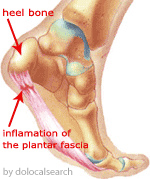Plantar Fascilitis
Heel Pain
Most heel pain is caused when a band of tissue in the foot, known as the plantar fascia, becomes damaged and thickens.
Plantar fascilitis is the medical term for the thickening of the plantar fascia.
The Plantar Fascia
 The plantar fascia is a tough and flexible band of tissue that runs under the sole of the foot. It connects the heel bone with the bones of the foot and acts as a kind of shock absorber to the foot. The plantar fascia is a tough and flexible band of tissue that runs under the sole of the foot. It connects the heel bone with the bones of the foot and acts as a kind of shock absorber to the foot.
Sudden damage or damage that has occurred over many months or years can cause tiny tears (microtears) to develop inside the tissue of the plantar fascia. This causes the plantar fascia to thicken which results in heel pain.
Who Gets Heel Pain?
People who run or jog regularly, and older adults who are 40-60, are the two main groups affected by heel pain.
Treating Heel Pain
- Resting your heel - rest the affected foot whenever possible, avoid walking long distances and standing for long periods.
- Pain relief - using an icepack on the heel and taking painkillers
- Exercise - exercises designed to stretch both your calf muscles and your plantar fascia should help relieve pain and improve flexibility in the affected foot.
- Wearing well fitted shoes that support and cushion your feet - running shoes
-
Stretching - there are a number of stretching exercises and recommended for both legs, even if only one of your heels are affected.
- Towel stretches - Keep a long towel by the side of your bed and before you get out of bed in the morning, loop the towel around your foot and use it to pull your toes towards your body, while keeping your knee straight. Repeat 3 times on each foot.
- Stair stretches - Stand on a step facing upstairs. Using the banister for support, feet slightly apart hang your heels off the back of the step. Lower your heels until you feel a tightening in your calves, hold this position for about 40 seconds, raise your heels back and repeat this procedure about six times, twice a day.
- Using supportive devices - orthosis are insoles that fit inside your shoe to support your foot and help your heel recover. If your pain does not respond to treatment and keeps recurring, or if you have an abnormal foot shape or structure, custom-made orthoses are available. These are specifically made to fit the shape of your feet.
Prevention of Heel Pain
Wearing appropriate footwear is very important and ideally you should wear a low to moderate heel that supports and cushions your arches and heels. Avoid wearing shoes without heels.
Being overweight can place excess pressure and strain on your feet. This increases the risk of damaging your feet and heels. Try to lose weight and maintain a healthy weight by combining regular exercise and healthy eating.
Healthy feet
Wearing high heels occasionally, maybe an evening out, is unlikely to be harmful. However, wearing them all day and week at work may damage your feet. Don't walk barefoot on hard ground, particularly when on holiday. Many cases of heel pain occur when a person protects their feet for 50 weeks of the year and then suddenly walks barefoot whilst on holiday. Their feet are not accustomed to the extra pressure.
If your choice of activity is running or another form of exercise that places strain on your feet, you should always replace your sports shoes regularly. The recommendation is that sports shoes should be replaced after you have done about 500 miles in them.
Plantar Release Surgery
Plantar release surgery is used for heel pain. The surgeon will cut the fascia to release it from your heel bone and reduce the tension in your plantar fascia.
- Open surgery - where the section of the plantar fascia is released by making a cut into your heel
- Endoscopic or minimal incision surgery - where a smaller incision is made and special instruments inserted into it to gain access to the plantar fascia.
Plantar Fascilitis, Heelpain, Treatment, Exercises, Prevention, Surgery
Brentwood, Billericay, Basildon, Wickford, Romford, Hornchurch, Rayleigh, Chipping Ongar, Upminster, Chingford, Chelmsford
Back to top
|

